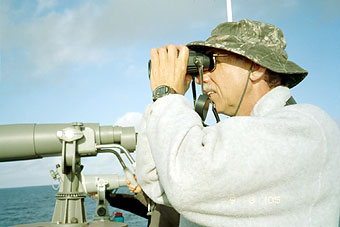

 | |||||||
|
|
Journals 2005/2006Maureen Barrett
August 24, 2005 We were off effort most of the day today due to high winds and rough seas. The winds formed whitecaps on the sea surface making it very difficult to spot cetaceans. The Beaufort scale was a 6, meaning the winds were between 22-27 knots. Even though the mammal observers were off effort, the bird observers were on effort scanning the sky. There are two bird observers on this leg of CSCAPE: Scott Mills and Tom Staudt. Like the mammal observers, they also work from the flying bridge. Their job is to identify and count all the seabirds, pinnipeds, and sharks.
Scott and Tom usually do two-hour shifts, with only one of them working at a time. They monitor a 300 meter transect from the bow of the boat 90° either port or starboard. The side they work is usually determined by the wind direction and the sun. When they see a seabird, they note the distance, species, number seen, behavior, and, if possible, age and sex. The data immediately gets entered into their computer (different from the mammal observers' computer). The distance is entered according to the zone the animal was in: 1-100 meters, 100-200 meters, 200-300 meters, or out of transect area. They use 7-10 power handheld binoculars to collect their data, and they also have access to big eyes. Some of the species seen so far on this leg have been Buller's Shearwater, Black-footed Albatross, Long-tailed Jaeger, Parasitic Jaeger, Arctic Tern, Tufted Puffin, Red-necked Phalarope, and Red Phalarope. I asked Scott why the Parasitic Jaegers are called parasitic. Apparently the Parasitic Jaegers will follow and harass Arctic Terns and other seabirds until they drop their fish. The same transect procedure is also used for the shark and pinniped data collection. So far, we have recorded sea lions and a 6-7 foot thresher shark. I was wondering where seabirds nest. I was amazed to find out that the birds that we are seeing nest in many different places in the world. Black-footed Albatrosses nest in Hawaii, Long-tailed Jaegers on the Arctic tundra, Sooty and Buller's Shearwaters nest in New Zealand, and Pink-footed Shearwaters on the islands off the coast of Chili. Leach's Storm-petrels nest close by on islands off the coast of California, Oregon, and Washington. Many seabirds are incredible flyers. Most have long wings and are fast flyers. They use little energy while flying because they glide so often using updrafts from waves. Arctic Terns are among the species with the longest migration in the world. They migrate from the Arctic to Antarctic waters; basically from pole to pole! Most seabirds have a very good sense of smell. Resources out in the open ocean are often scarce, so seabirds need to be able to locate food from great distances. In general, shallow, coastal waters are more productive. Black-footed Albatrosses are obviously aware of this and some travel from their nesting grounds in Hawaii to the coastal waters off California. These birds are traveling thousands of miles to get food for their young. I am amazed at how fast both the bird and mammals scientists can identify species in the wild, sometimes only getting a glimpse at the animal. |
||||||
